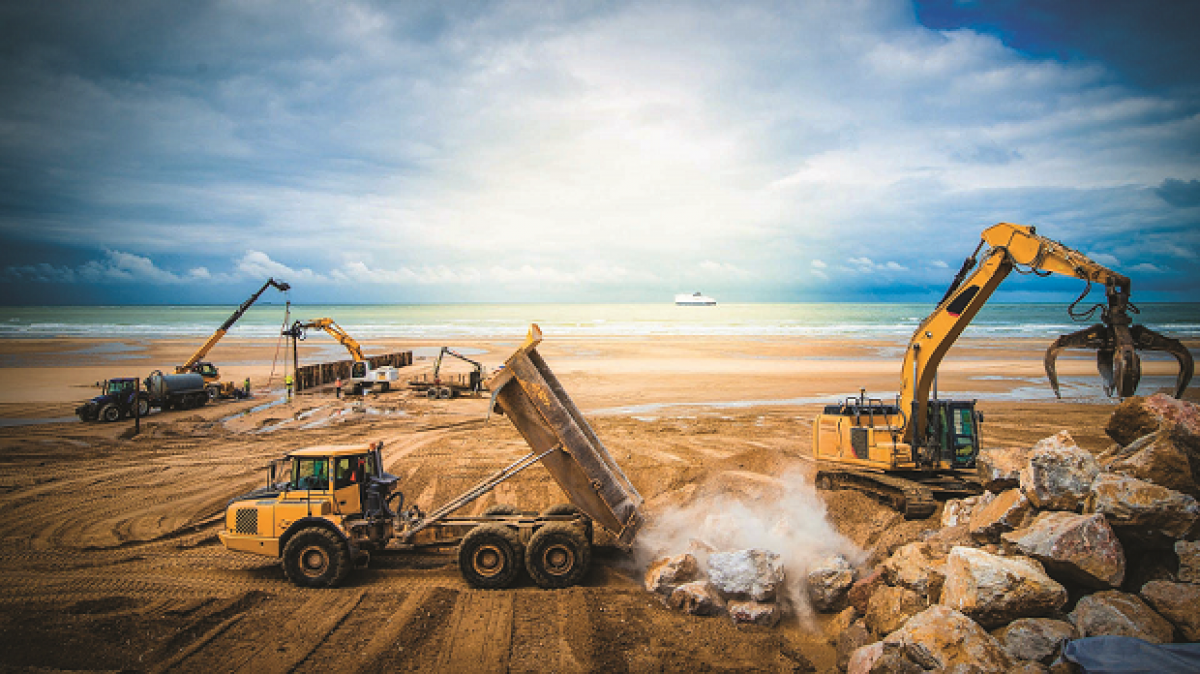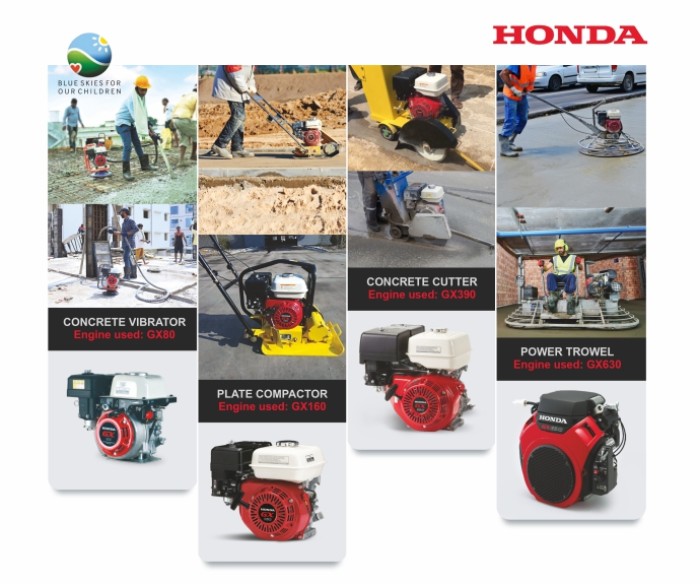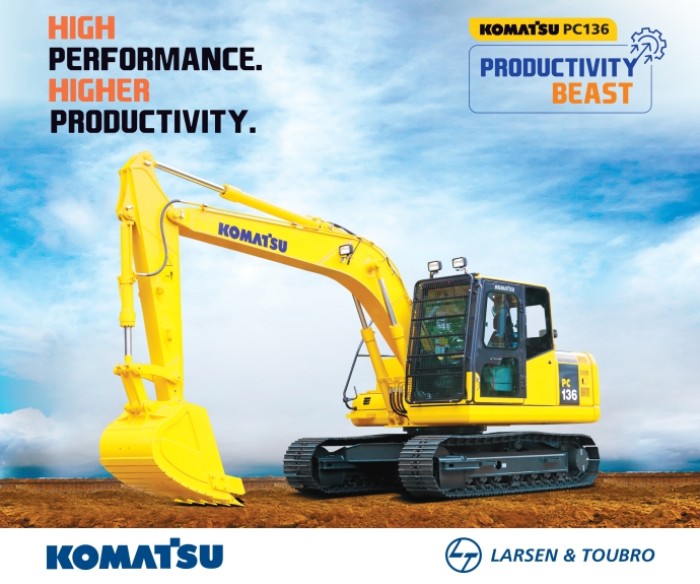Advancements in the Construction Equipment Industry; From Electric Equipment to IoT
In the construction industry, where business objectives are strictly time and margin driven, modern construction equipment is critical. Modern construction equipment is extremely fast and dependable, and it has high-quality control measures built into it as it has evolved over time. The proper use of this equipment contributes to the project's economics, quality, safety, speed, and timeliness. It optimises the use of material, manpower, money, and the scarcity of competent and efficient labour while also keeping a close eye on the quality controls in place.
Construction equipment powered by electricity isn't a new concept. For years, hybrid electric machines have been accessible, and now all-electric excavators, loaders, forklifts, and other heavy machinery may be rented or purchased all over the world. Continue reading to learn more about the advantages of electric construction equipment and the different sorts of machines that are causing a stir in the industry. Beyond lowering emissions, electrification has a number of advantages. Reduced noise levels are achieved by minimising or completely eliminating the usage of an engine in electrical equipment, resulting in better comfort and safety for operators and others on the job site. This permits the equipment to be utilised within buildings, on construction sites in the city, and in other noise-sensitive places.
If you've ever driven past a construction site, you've probably noticed that most of the heavy equipment is powered by diesel fuel. While diesel-powered construction equipment continues to be the most common, all-electric ones are becoming more common than you might imagine – and they tend to fit in nicely.
All-electric equipment is nearly equal to its diesel counterpart in terms of total performance capability. Volvo CE, for example, stated that the specs of its electric excavator and wheel loader are identical to those of their diesel counterparts. The only distinctions are that their electric equipment has a little larger working weight and a tiny increase in continuous motor power.
Electric Construction Equipment
Because the construction sector is notorious for being sluggish to accept new technologies, not all machines are currently available in electric versions. However, as technology progresses, equipment makers are gradually releasing new versions.
Excavators:Electric excavators were among the first all-electric machines to be introduced to the public. At the Volvo Group Innovation Summit in 2017, Volvo CE unveiled its EX02 tiny electric excavator prototype. In place of a standard combustion engine, the EX02 emitted zero emissions and contained two lithium-ion batteries. The batteries have a total capacity of 38 kWh, allowing the machine to dig for eight hours between charges.
While the EX02 model was only a prototype that was never commercially available, Volvo CE has since unveiled the ECR25 Electric excavator. This model is presently available for pre-order in the United States and Canada, with the first deliveries expected in June 2022.
Electric excavators have been introduced by companies including Caterpillar, Bobcat, Doosan, Hyundai CE, and JCB in recent years, and the trend is set to continue as demand for all-electric heavy machinery grows.
Wheel Loaders:Wheel loaders exist in a variety of sizes and types, and they're common on construction sites, so manufacturers rushed to build all-electric ones. Within the last five years, businesses like Wacker Neuson and Schäffer have debuted their own models, while Volvo CE has added the L25 Electric compact wheel loader to its all-electric roster.
The Schäffer 24E, billed as the world's first lithium-ion-powered electric wheel loader, is powered by two lithium-ion batteries and has two hydraulic motors. The machine is tiny and quiet, making it ideal for maintenance chores in residential areas where noise is a concern. Its lightweight design allows it to be easily loaded onto a car trailer, and it can be easily transported between construction sites.
Dump Trucks and Mining Trucks:A 45-ton mining truck designed by the German company Kuhn Schweiz is the world's largest electric vehicle. This all-electric truck, dubbed the Elektro Dumper, transports marlstone and, because to its regenerative braking technology, never needs to be recharged. When the truck descends a slope, the braking system absorbs and stores the energy created by the downhill movement in the truck's 600 kW per hour battery pack.
While the Elektro Dumper is now a one-of-a-kind unit, other equipment manufacturers have produced electric mining trucks of their own. For example, Epiroc makes a battery-powered mine vehicle that may be used underground.
Forklifts: Because forklifts are smaller than other types of heavy gear, creating all-electric vehicles presented fewer challenges. Cat recently added four electric forklift trucks to its product line, and Toyota currently provides five electric models.
As more goods join the market, the electric forklift market is getting increasingly competitive. Cat enhanced its electric lift trucks with built-in service reminders, on-the-go system monitoring, and self-diagnostics technology to keep ahead of the competition.
Digitalisation in Construction Equipment Industry
Digital solutions put action and information at the fingertips of construction contractors, whether they need to rent or return equipment, identify equipment, or monitor utilisation. Construction teams can locate and perform what they need, no matter where they are or what device or tool they are using, thanks to digital technology like telematics, online self-service tools, and fleet management. Contractors of all sizes can benefit from these solutions, which can help them better manage complex projects and reduce underutilization of equipment such as excavators, loaders, aerial work platforms, and more.
Increasing Productivity with IoT
Productivity improvement is a top priority for businesses all around the world. Because of the rise in global urbanisation, productivity is not only a priority, but also an urgent challenge in the construction business. One option to solve these difficulties is to use IoT-enabled technology to increase productivity and manage projects more efficiently while lowering operating expenses.
IoT has already made a significant difference in the building business. IoT solutions, when combined with 5G developments, may provide businesses with faster speeds and lower latency, allowing them to create more bandwidth for the myriad of tools, resources, and technology utilised both on and off-site. Smart construction sites are made possible by deploying sensors that track key performance indicators, equipment turnover, utilisation rates, and inventories, among other improvements in construction deriving from long-range, low-power technology.
Benefits from the Internet of Things in three ways
There are three areas where IoT implementation will offer benefits as expectations become more stringent across construction sites and organisations are compelled to react to account for changing market needs: productivity, safety, and site operations.
Productivity: The most pressing issue confronting the construction sector today is productivity. The rise of IoT in construction is fueled by the growing desire to avoid project delays. Companies must stay on track in a deadline-driven industry since delays increase the budget. By tracking equipment and deliveries, IoT-enabled sensors help keep firms on track and optimise daily chores like scheduling and inspections. Both equipment and employees are monitored using digital management solutions. Managers may access the location and configuration of equipment, as well as links to quality control sheets, by viewing and navigating a virtual map in real time.
Safety and security: At every building site, safety is a key priority. Productivity will always suffer without healthy staff and a safe working environment. Fortunately, IoT-enabled tags with sensors can track a piece of equipment on a site dashboard for possible concerns, such as air quality, or receive alarms when an employee approaches a piece of machinery too closely. Workers can take preventative action and halt a potentially dangerous scenario by accessing data in real time. IoT-enabled tags are also used to help prevent theft on construction sites. These tags make tracking and monitoring equipment more easier, removing the need for ongoing supervision. Additionally, because construction equipment theft and material costs are soaring, they can save construction companies hundreds of thousands of dollars per year.
Operation of the site: The cost of power and fuel usage are two of the most significant costs involved with a construction site. IoT devices, such as fuel sensors or load sensors, can help businesses actively control expenses by monitoring and managing assets in real time. Managers may then schedule, turn on and off, and idle equipment at all hours of the day and night to increase efficiency and cut expenses, as well as assess the quality of equipment to prevent problems and indicate when stock or condition is low-functioning or damaged.
How IoT helps in Equipment Maintenance?
The Internet of Things (IoT) is rapidly infiltrating every industry, with applications in both commercial and household settings. Everything with the word "smart" as a prefix in your home, life, or office is a networked component of the IoT. Appliances, thermostats, and lightbulbs may all be controlled by residential devices. The possibilities in an industrial setting are practically endless.
Here's how the Internet of Things is helping to enhance construction equipment upkeep, efficiency, worker safety, and the bottom line.
Data Collection in Real-Time: One of the most crucial elements in developing an effective maintenance programme is data. Previously, all of this data had to be manually obtained, either from the machine's onboard computer or from a manual database of equipment maintenance histories. This may have worked in the past, but with the expanding size of construction fleets, it is no longer feasible.
Fleet operators can collect data about each piece of equipment in real time by incorporating IoT sensors. Because one particular piece isn't scheduled for inspection yet, you won't miss key signals that could lead to equipment failure. The sensors can inform the operator or fleet management to take the vehicle offline for inspections and repairs if something starts to fail or needs attention to avoid a breakdown.
Depending on the location and programming of the sensors, the IoT could even potentially tell you when an item needs to be washed. Keeping an item clean can sometimes help it function better and last longer.
Maintenance that is planned Rather than Preventive Maintenance: Preventive maintenance is an essential component of any fleet management system. Regular inspections and a strict upkeep schedule might help you avoid problems before they become serious, but what if you could forecast when a certain component will fail? By combining the data collected by IoT sensors with a machine learning system, you can turn your preventive maintenance programme into a predictive one.
This isn't a form of magic, nor is it a method of foretelling the future. Predictive algorithms, on the other hand, sort through historical data and make statistical forecasts. A predictive system's accuracy improves as the amount of data it has to deal with grows.
Defending Against Theft, Damage, and Loss: When a fleet is still on the job site, it's much easier to maintain it. IoT sensors can be used to track the location of equipment using Bluetooth, GPS, or RFID signals in addition to relaying maintenance data in real time.
This is also a useful tool for anyone looking to improve job site operating efficiency. You may examine hours of operation, idle time, and other metrics by tracking the movement of a piece of equipment, which can help you establish a more efficient and productive job site. You'll also know if a specific item is used more frequently than others, which could signal that investing in additional machine is a wise option in the future.
Raising the Bar for Sustainability: Making construction work more sustainable is one of the most important goals in the construction business right now. Massive diesel engines and heavy equipment aren't exactly eco-friendly, and even some of the most basic materials, like the stakes used to mark out the worksite, may be made more environmentally friendly. It may be easier to establish the best method to make a fleet more sustainable by incorporating IoT into construction equipment. Everything from idle time to the amount and composition of emissions can be monitored to see if there are any issues affecting fuel efficiency or other issues that need to be addressed in order to lessen the device's carbon footprint. A piece of equipment that is poorly maintained or operated inefficiently will produce more pollutants and cause more issues in the long term.
On-the-Job Safety for Operators: On a typical construction site, there are so many different types of construction equipment that it can be difficult to keep track of them all. Operators may have a basic idea of how they all work, but cross-training everyone on every equipment is difficult. When anything is involved in an accident that results in harm or death, it is normally taken down during the inquiry. Taking efforts to keep employees safe on the work is the easiest approach to avoid this.
By combining IoT-based proximity sensors with wearable technology for operators, the two can avoid colliding. When a sensor on a piece of heavy machinery detects that someone is approaching too closely, it can shut down the machine until the warning is cleared and the person in danger walks out of the danger zone.
Keeping Downtime to a Minimum: In the short term, skipping maintenance may seem like a good idea, but it will cost you in the long run. An object that isn't consistently maintained will ultimately break down, and if Murphy's Law has anything to say about it, it will do so at the most inopportune time. The last thing you need is a scheduling conflict to throw your schedule off.
Downtime is costly, and the price may vary depending on the specifics of your organisation. This can be disastrous for small construction companies, especially if any necessary repairs take more than a few hours to accomplish. It makes no difference whether you use predictive or preventive maintenance schedules in this scenario. Any investment that keeps your fleet running smoothly and avoids costly downtime is a good one.
Making Automation Less Difficult: The construction industry has historically been one of the last to accept new technologies, preferring to stick to more traditional ways. Despite this tendency to remain huddled in its shell, automation is making inroads into the industry. The Internet of Things (IoT) and its network of networked sensors can make automation easier to implement and incorporate into existing practises and procedures.
It's simple to connect automation hardware to current IoT networks once it's set up. The more these systems communicate with one another, the easier it will be for them to work together. Automation will never completely replace the workers in the construction business — or any other industry that requires a lot of human initiative and creativity. It can, however, make many professions much easier and safer while freeing up workers' time to do other things.
Challenges and Opportunities in Construction Equipment
Construction equipment is mostly used to create residential and non-residential structures such as tunnels, highways, and other structures. Underground mining, drilling, mineral processing, and surface mining all require mining equipment. Due to the existence of mining equipment, labour has been minimised and explosions have been eliminated. The project was completed on time thanks to innovation in the construction and mining equipment industries.
The years 2020 and 2021 have been remarkable, and the pandemic has had an impact on projects all across the world. In the future years, we should expect infrastructure and mining projects to get underway, providing us with more opportunity to touch people's lives and improve India's infrastructure needs.
The impact of the second wave of the COVID 19 epidemic was felt in the construction industry, as well as other industries. However, it is important to highlight that the construction sector in India plays a large role, accounting for almost 60% of overall investments; as a result, it must rebound quickly to help the economy recover.
India's economy is expanding at a rapid pace. All areas of fundamental infrastructure, such as metro, rail, roadways, expressways, airports, and growth on existing highways, require speed and emphasis in today's building and infrastructure segment. The primary problem that manufacturers face is bringing new technologies to market on a regular basis. Market leaders are constantly innovating in order to come out with sophisticated technological items that will allow them to grow faster than the industry.
Losses from idling equipment, as well as a lack of particular incentives or plans to finance the import of high-tech construction equipment for infrastructure projects, are some of the key issues.
Opportunities
The construction equipment industry in India has the most potential for expansion and growth, as well as the most prospects for investment. Infrastructural projects by public and private enterprises, such as building construction, tunnels, maintenance, road construction, power plants, ports, and urban infrastructural developments, are now driving demand for construction equipment in India. With the launch of smart cities in India, it has also seen incremental growth. Due to rising modernization in infrastructure, mining, and building in India, the construction and mining equipment sector in India will change.
This also suggests that the Indian equipment sector will grow rapidly in the next years. To stress indigenization, the sector can provide specialised and cost-effective solutions to meet domestic needs. It will be a huge help to suppliers in terms of improving margins and prices. Scholarships for manpower training, as well as increased knowledge of the benefits of using qualified labour, training programmes, and specific grants, can be regarded a boon to the sector.
One of the major elements for the construction ecosystem is close coordination between industry, government, and policymakers to guarantee that the sector's issues are overcome, paving the way for the country's growth and prosperity. The concept of used-equipment exchange and buyback schemes can assist boost the used machinery market's sales.
Because of the increased focus on road building and the rebound in the mining and quarrying segment, there is continuous demand for portable compressors in the construction and mining industry. Moreover, the waterwell industry contributes to the demand for big compressors for borehole applications.
















Leave a comment